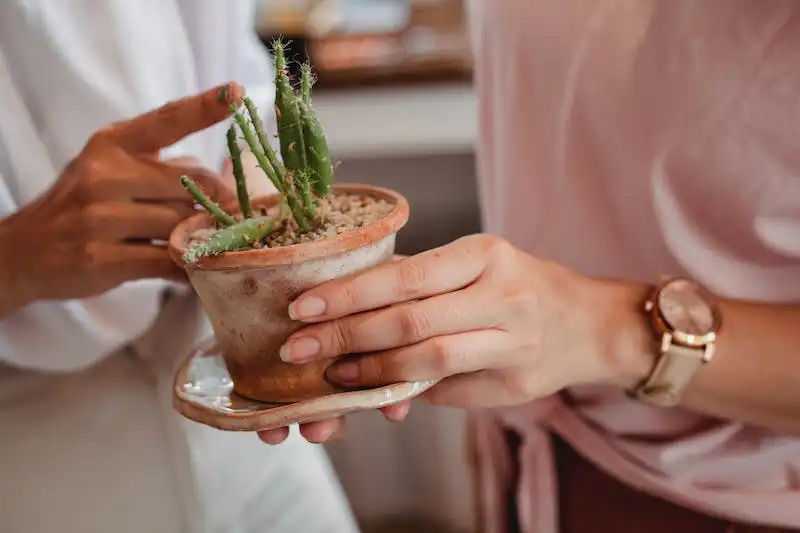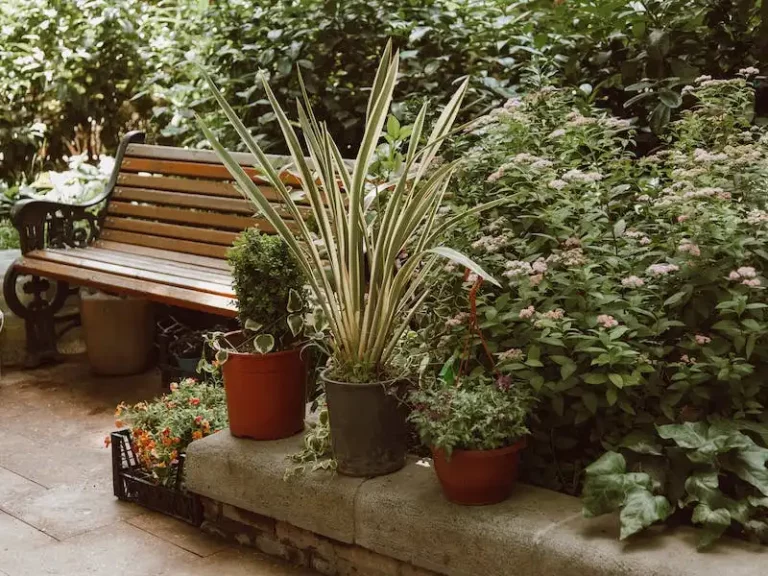Planting plug plants is a great way to add variety and color to your garden. Whether you’re new to gardening or a seasoned pro, these tips will help you successfully grow plug plants in pots or trays.
Before you begin potting up your plug plants, it’s important to make sure you have everything you need. A potting tray, potting soil, and water supply are essential. You’ll also want to have a plugger on hand, which is a handy tool for taking plug plants out of their trays.
When potting up your plug plants, start by loosening the soil in their trays. This will help them grow better once they’re transplanted. If the plugs are very tight and compacted, lightly spraying them with water can make it easier to remove them from the tray.
Instead of planting the plugs directly into the pot or tray, you can actually take cuttings from them to propagate more plants. This is especially useful if you want to grow a lot of the same variety. By taking cuttings, you’ll be able to have a larger supply of plants for your garden.
When filling your pots or trays with soil, make sure to leave a 1-inch gap at the top. This will allow for watering and prevent the soil from spilling over. Additionally, you can use a minimum of 3 plugs per pot or tray to determine the size of your planting groups.
After planting your plug plants, it’s important to water them well. Watering them once a week should be sufficient, but be sure to check the moisture levels regularly. You’ll also want to add a layer of mulch around the plants to help retain moisture and suppress weeds.
As your plug plants grow, you may need to move them to a larger pot or directly into the ground. This is especially true for plants like geraniums and begonias, which can grow quite large. Alternatively, you can group smaller plug plants together to create a visually appealing display in your yard.
By following these tips, you’ll be well on your way to successfully planting and growing plug plants. With a little care and attention, you’ll soon have a beautiful garden full of vibrant and healthy plants.
Transplanting Plugs and Grouping Plants
When it comes to planting and growing plug plants, there are a few important steps to follow to ensure their success. One key step is transplanting plugs and grouping plants. This is the process of moving the plug plants from their original containers to their final planting location.
Transplanting plugs is relatively easy. Once the plug plants have been purchased, it is important to plant them as soon as possible to prevent any damage or stress to the plants. If they cannot be planted immediately, place them in a shady spot and keep the roots moist.
Before transplanting, it is important to prepare the planting area. Determine where you want to plant the plugs and make sure the soil is in good condition. Loosen the soil and remove any weeds or grass that may interfere with the growth of the plugs.
If you are planting plugs directly into the ground, dig a hole that is slightly larger than the size of the plug and place the plug into the hole. Make sure the top of the plug is level with the surrounding soil. Fill in the hole with soil and gently press it down to secure the plug in place.
If you are grouping plants together, you can plant them in a bed or container. Determine the desired design and spacing for the plants. Dig a hole or trench that is large enough to accommodate the group of plants and place them in the hole or trench. Fill in the hole or trench with soil and press it down gently to secure the plants in place.
When transplanting plugs or grouping plants, it is important to water them thoroughly after planting to settle the soil and provide moisture for the roots. Additionally, monitor the plants closely after transplanting to ensure they are adapting well to their new location.
Transplanting plugs and grouping plants is an effective way to quickly establish a landscape design or fill in gaps in the garden. It allows you to obtain plants in larger quantities and in a smaller size, which makes them easier to handle and plant. By following these steps and tips, you can effectively transplant plugs and group plants to create the desired effect in your garden or landscape.
How to plant and grow plug plants
Planting and growing plug plants is a cheap and easy way to quickly add color and variety to your landscape. With a little planning and the right care, you can enjoy beautiful flowers and plants in no time.
Before you start, determine the best time to plant your plug plants. Some plants are better suited for early spring, while others thrive in the summer or fall. The information provided with your plug plants will typically give you guidance on the best planting time.
When your plug plants arrive, keep them in a cool, shaded area until you’re ready to plant. If you can’t plant them immediately, make sure to keep the roots moist by spraying them with water or placing them in a tray of water.
Prepare the ground by thoroughly loosening the soil and removing any weeds or debris. If you’re planting in pots, make sure they have drainage holes and fill them with potting soil.
When planting your plug plants, dig a hole that is slightly larger than the plug itself. Gently loosen the roots and place the plug in the hole, making sure it is at the same level as the surrounding soil. Firmly press the soil around the plug to ensure good contact.
After planting, water thoroughly to settle the soil and help the roots establish. Watering through the root system will also help prevent dry spots. If you have a large area to plant, consider using a system that will allow you to water multiple plants at once.
To keep your plug plants healthy, it’s important to provide them with the right care. Depending on the plant varieties, they may have different requirements for sunlight, water, and fertilization. Make sure to read the plant’s care instructions or do some research to guarantee they receive the proper care.
In terms of maintenance, regular watering is essential, especially during dry periods. Mulching around the plants can help retain moisture and prevent weeds. Some gardeners also use mulches to keep the soil temperature more consistent.
Having a regular feeding schedule is also important. Applying a liquid fertilizer or slow-release pellets according to the directions can help promote healthy growth and abundant blooms.
As your plug plants grow, they may benefit from some additional support. Consider adding stakes or trellises for tall or climbing plants. This will help prevent them from falling over or getting damaged by strong winds.
If you have tender plug plants that are not yet mature enough to withstand harsh weather, consider grouping them together or placing them in a sheltered area. This will help protect them from cold temperatures and reduce the risk of damage.
When it comes to pests and diseases, it’s important to keep a close eye on your plug plants. Remove any dead or diseased foliage immediately to prevent the spread of diseases. If you notice pests, such as aphids or snails, take appropriate measures to control them.
Finally, don’t forget to enjoy your beautiful plug plantings! Regularly inspect them to see how they’re doing and appreciate the progress they’re making. As they grow and mature, they will add a lot of visual interest to your landscape.
By following these steps and providing the right care, you can easily plant and grow plug plants to create a stunning and colorful garden.
What are plug plants
Plug plants are small, established plants that are grown in individual cells and are ready to be planted directly into the ground or containers. They are typically sold in trays and can be obtained from garden centers, nurseries, or online retailers. These plants are a convenient and easy way to get started with your gardening projects, whether you are a beginner or an experienced gardener.
Plug plants are usually grown in groups of several plants in a single tray, with each plant having its own individual cell. The cells provide a controlled environment for the roots to grow and develop. This allows the plants to establish themselves quickly and have a better chance of survival upon planting.
The main benefits of using plug plants are that they save you time and hassle. Instead of starting from seeds and waiting for the plants to germinate and grow, you can simply plant the ready-to-go plug plants directly into your garden or containers. This can be especially useful if you want to fill a large area or create a specific design in your garden.
When planting plug plants, the first step is to prepare the soil. You can do this by loosening the soil, removing any weeds or large stones, and adding compost or other organic matter to improve its fertility. Once the soil is prepared, you can start planting the plug plants.
To plant the plug plants, simply dig a hole in the soil with a trowel or a plugger planter, deep enough to accommodate the roots. Gently remove the plant from its cell and place it into the hole, making sure that the roots are well covered. Press the soil around the plant to secure it in place.
After planting, it’s important to water the plug plants thoroughly to help them establish and reduce the risk of transplant shock. You can water them using a watering can or a hose with a gentle spray. Watering directly at the base of the plants will ensure that the roots receive an adequate supply of water.
As the plug plants grow, it’s important to keep them well-watered and to monitor their growth. Depending on the type of plants you are growing, you may need to water them daily or every few days. It’s also important to keep an eye out for any signs of pests or diseases, as early detection can prevent their spread and damage to the plants.
In addition to watering, there are several ways you can care for your plug plants to promote their healthy growth. These include providing adequate sunlight, fertilizing as needed, and protecting them from extreme weather conditions. Mulches can also be used to suppress weed growth and conserve moisture in the soil.
Once your plug plants have become established and have developed a strong root system, they can be planted out into their final positions in the garden. This can be done by carefully removing them from their trays or cells and planting them directly into the prepared soil. Alternatively, you can plant them into containers or hanging baskets for a container garden.
In conclusion, plug plants are a convenient and easy way to grow a wide range of plants in your garden. They offer the benefits of saving time and reducing the risk of transplant shock. By following the proper planting and caring techniques, you can enjoy a beautiful and thriving garden with the help of plug plants.
What to do when your plug plants arrive
When your plug plants arrive, there are a few important steps you can take to ensure their successful growth. Follow this handy potting-on guide to ensure your plants get off to the best start.
- Inspect the packaging: First and foremost, check the packaging to make sure your plug plants arrived in good condition. If there are any issues, contact the supplier within a week of receiving your order.
- Group the plants: If you ordered multiple plug plants, group them together based on their variety. This will make it easier to keep track of them and apply specific care guidelines.
- Water the plants: Before potting the plug plants, give them a thorough watering. This will help hydrate the plants and prepare them for the transition into their new pots or garden bed.
- Pot them up: Whether you plan to grow your plug plants in pots or directly in the ground, potting them up is a crucial step. Fill pots or prepare the planting area by loosening the soil and creating holes for each plant. Make sure the pot or hole is deep enough to accommodate the plant’s root system.
- Remove the plug plants: Gently remove the plug plants from their trays by snapping or cutting them away. Be careful not to damage the delicate roots.
- Planting in pots: If planting in pots, fill them with a good quality compost or potting mix. Place the plug plants in the pots, ensuring they are centered and at the same depth as they were in the tray. Firm the compost gently around the plants.
- Planting in the ground: If planting directly in the ground, make sure the soil is well-prepared. Remove any weeds, rocks, or debris, and loosen the soil with a garden fork or tiller. Dig individual holes for each plant, spaced according to the specific variety’s recommendations.
- Apply mulch: Once the plug plants are planted, applying mulch around the base of each plant can help conserve moisture, inhibit weed growth, and improve overall soil conditions. Spread a layer of mulch evenly between the plants, being careful not to mound it up against the stems.
- Water thoroughly: After planting and applying mulch, water the plug plants thoroughly. This will help settle the roots and provide immediate hydration. Keep an eye on the moisture levels and water as needed throughout the growing season.
- Care for tender plants: If you have ordered tender plants like begonias or snapdragons, protect them from cold temperatures and frosts by covering them with fleece or moving them to a warmer location.
- Enjoy your new plants: Once the plug plants are settled in their pots or garden beds, sit back, relax, and enjoy watching them grow. With proper care and maintenance, they will soon establish themselves and become beautiful additions to your landscape.
Remember, each variety of plug plant may have its own specific requirements, so be sure to read the provided care instructions or consult reputable gardening resources to ensure optimal growth.




